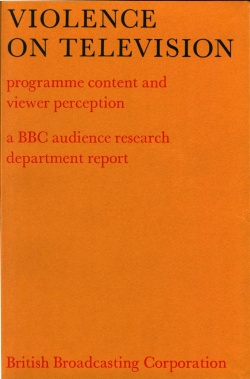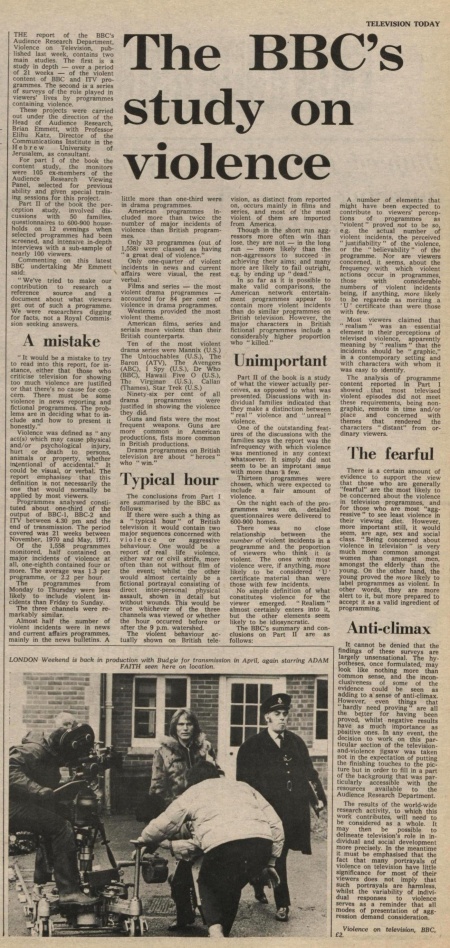The BBC's study on violence BBC makes important contribution

- Publication: The Stage and Television Today
- Date: 1972-02-03
- Author:
- Page: 12
- Language: English
THE report of the BBC's Audience Research Department, Violence on Television, published last week, contains two main studies. The first is a study in depth — over a period of 21 weeks — of the violent content of BBC and ITV programmes. The second is a series of surveys of the role played in viewers' lives by programmes containing violence.
These projects were carried out under the direction of the Head of Audience Research, Brian Emmett, with Professor Elihu Katz, Director of the Communications Institute in the Hebrew University of Jerusalem, as consultant.
For part I of the book the content study, the monitors were 105 ex-members of the Audience Research Viewing Panel, selected for previous ability and given special training sessions for this project.
Part II of the book the perception study, involved discussions with 50 families, questionnaires to 600-900 households on 12 evenings when selected programmes had been screened, and intensive in-depth interviews with a sub-sample of nearly 100 viewers.
Commenting on this latest BBC undertaking Mr Emmett said:
" We've tried to make our contribution to research a reference source and a document about what viewers get out of such a programme. We were researchers digging for facts, not a Royal Commission seeking answers.
A mistake
" It would be a mistake to try to read into this report, for instance, either that those who criticise television for showing too much violence are justified or that there's no cause for concern. There must be some violence in news reporting and fictional programmes. The problems are in deciding what to include and how to present it honestly."
Violence was defined as " any act(s) which may cause physical and/or psychological injury, hurt or death to persons, animals or property, whether intentional of accidental." It could be visual, or verbal. The report emphasises that this definition is not necessarily the one that would normally be applied by most viewers.
Programmes analysed constituted about one-third of the output of BBC-1, BBC-2 and ITV between 4.30 pm and the end of transmission. The period covered was 21 weeks between November, 1970 and May, 1971.
Of the 1,558 programmes monitored, half contained on major incidents of violence at all, one-eighth contained four or more. The average was 1.3 per programme, or 2.2 per hour. The programmes from Monday to Thursday were less likely to include violent incidents than Friday to Sunday.
The three channels were remarkably similar.
Almost half the number of violent incidents were in news and current affairs programmes, mainly in the news bulletins. A little more than one-third were in drama programmes.
American programmes included more than twice the number of major incidents of violence than British programmes.
Only 33 programmes (out of 1,558) were classed as having " a great deal of violence." Only one-quarter of violent incidents in news and current affairs were visual, the rest verbal.
Films and series — the most violent drama programmes — accounted for 84 per cent of violence in drama programmes.
Westerns provided the most violent theme.
American films, series and serials more violent than their British counterparts.
Ten of the most violent drama series were Mannix (U.S.) The Untouchables (U.S.), The Baron (ATV), The Avengers (ABC), I Spy (U.S.), Dr Who (BBC), Hawaii Five O (U.S.), The Virginan (U.S.). Callan (Thames), Star Trek (U.S.)
Ninety-six per cent of all drama programmes were justified in showing the violence they did.
Guns and fists were the most frequent weapons. Guns are more common in American productions, fists more common in British productions.
Drama programmes on British television are about "heroes" who "win."
Typical hour
The conclusions from Part I are summarised by the BBC as follows:
If there were such a thing as a " typical hour " of British television it would contain two major sequences concerned with violence or aggressive behaviour. One would be a report of real life violence, either war or civil strife, more often than not without film of the event; whilst the other would almost certainly be a fictional portrayal consisting of direct inter-personal physical assault, shown in detail but without wounds. This would be true whichever of the three channels was viewed or whether the hour occurred before or after the 9 p.m. watershed.
The violent behaviour actually shown on British television, as distinct from reported on, occurs mainly in films and series, and most of the most violent of them are imported from America.
Though in the short run aggressors more often win than lose. they are not — in the long run — more likely than the non-aggressors to succeed in achieving their aims; and many more are likely to fail outright, e.g. by 'ending up " dead."
In so far as it is possible to make valid comparisons, the American network entertainment programmes appear to contain more violent incidents than do similar programmes on British television. However, the major characters in British fictional programmes include a considerably higher proportion who " killed."
Unimportant
Part II of the book is a study of what the viewer actually perceives, as opposed to what was presented. Discussions with individual families indicated that they make a distinction between " real " violence and " unreal " violence.
One of the outstanding features of the discussions with the families says the report was the infrequency with which violence was mentioned in any context whatsoever. It simply did not seem to be an improtant issue with more than a few.
Thirteen programmes were chosen, which were expected to include a fair amount of violence.
On the night each of the programmes was on, detailed questionnaires were delivered to 600-900 homes.
There was no close relationship between the number of violent incidents in a programme and the proportion of viewers who think it is violent. The ones with most violence were, if anything, more likely to be considered ' U ' certificate material than were those with few incidents.
No simple definition of what constitutes violence for the viewer emerged. " Realism " almost certainly enters into it, but the other elements seem likely to be idiosyncratic.
The BBC's summary and conclusions on Part II are as follows:
A number of elements that might have been expected to contribute to viewers' perceptions of programmes as "violent " proved not to be so, e.g. the actual number of violent incidents, the perceived " justifiability " of the violence, or the " believability " of the programme. Nor are viewers concerned, it seems, about the frequency with which violent actions occur in programmes, those with considerable numbers of violent incidents being, if anything, more likely to be regareded as meriting a ' U ' certificate than were those with few.
Most viewers claimed that " realism " was an essential element in their perceptions of televised violence, apparently meaning by " realism " that the incidents should be " graphic," in a contemporary setting and with characters with whom it was easy to identify.
The analysis of programme content reported in Part 1 showed that most televised violent episodes did not meet these requirements, being non-graphic, remote in time and/or place and concerned with themes that rendered the characters " distant" from ordinary viewers.
The fearful
There is a certain amount of evidence to support the view that those who are generally "fearful" are the most likely to be concerned about the violence in television programmes, and for those who are most "aggressive " to see least violence in their viewing diet. However, more important still, it would seem, are age, sex and social class. " Being concerned about violence in television " is very much more common amongst women than amongst men, amongst the elderly than the young. On the other hand, the young proved the more likely to label programmes as violent. In other words, they are more alert to it, but more prepared to accept it as a valid ingredient of programming.
Anti-climax
It cannot be denied that the findings of these surveys are largely unsensational. The hypotheses, once formulated, may look like nothing more than common sense, and the inconclusiveness of some of the evidence could be seen as adding to a sense of anti-climax. However, even things that " hardly need proving " are all the better for having been proved, whilst negative results have as much importance as positive ones. In any event, the decision to work on this particular section of the television-and-violence jigsaw was taken not in the expectation of putting the finishing touches to the picture but in order to fill in a part of the background that was particularly accessible with the resources available to the Audience Research Department. The results of the world-wide research activity, to which this work contributes, will need to be considered as a whole. It may then be possible to delineate television's role in individual and social development more precisely. In the meantime it must be emphasised that the fact that many portrayals of violence on television have little significance for most of their viewers does not imply that such portrayals are harmless, whilst the variability of individual responses to violence serves as a reminder that all modes of presentation of aggression demand consideration.
Violence on television, BBC, £2.
Disclaimer: These citations are created on-the-fly using primitive parsing techniques. You should double-check all citations. Send feedback to whovian@cuttingsarchive.org
- APA 6th ed.: (1972-02-03). The BBC's study on violence BBC makes important contribution. The Stage and Television Today p. 12.
- MLA 7th ed.: "The BBC's study on violence BBC makes important contribution." The Stage and Television Today [add city] 1972-02-03, 12. Print.
- Chicago 15th ed.: "The BBC's study on violence BBC makes important contribution." The Stage and Television Today, edition, sec., 1972-02-03
- Turabian: "The BBC's study on violence BBC makes important contribution." The Stage and Television Today, 1972-02-03, section, 12 edition.
- Wikipedia (this article): <ref>{{cite news| title=The BBC's study on violence BBC makes important contribution | url=http://cuttingsarchive.org/index.php/The_BBC%27s_study_on_violence_BBC_makes_important_contribution | work=The Stage and Television Today | pages=12 | date=1972-02-03 | via=Doctor Who Cuttings Archive | accessdate=22 June 2025 }}</ref>
- Wikipedia (this page): <ref>{{cite web | title=The BBC's study on violence BBC makes important contribution | url=http://cuttingsarchive.org/index.php/The_BBC%27s_study_on_violence_BBC_makes_important_contribution | work=Doctor Who Cuttings Archive | accessdate=22 June 2025}}</ref>
